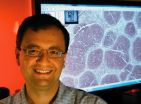(Press-News.org) Researchers at National Jewish Health have discovered a signaling pathway that is crucial to the devastating effects of acute lung injury (ALI). The data, obtained from cells, animals and ALI patients, suggest several potential therapeutic targets. Experimental blockade of one of the targets significantly reduced flooding of the lungs that is the hallmark of ALI.
"Acute lung injury is a devastating disease, with 40 percent mortality and no beneficial therapies," said first author James Finigan, MD, Assistant Professor of Medicine at National Jewish Health. "Our study identifies several promising targets for therapy, including HER2, which is already targeted by existing breast-cancer medications."
About 200,000 people in the United States suffer acute lung injury (ALI) every year. It is caused by either direct injury to the lungs or as a result of other conditions, often pneumonia or systemic infection. In ALI, large amounts of protein-rich fluid flow from the capillaries into the lungs, leading to flooding of the airspaces and reduced ability to deliver oxygen to the blood. Severe ALI is often referred to as acute respiratory distress syndrome or ARDS. Currently there is no approved therapy for the disease. Care of ALI patients is supportive only, in which doctors try to maintain blood-oxygen levels. Approximately 40 percent of patients with ALI, or 90,000 people per year in the US, die.
Dr. Finigan and his colleagues had previously shown that HER2, a receptor involved in cell development and growth, participates in recovery of mice from chemically-induced lung injury. They hypothesized that it may also play a role in the earlier inflammatory phase of lung injury, which resembles ALI in mice. The researchers also knew that the inflammatory molecule interleukin-1β is a central player in ALI and the permeability of capillaries.
In a series of experiments in cell culture and animal models they connected interleukin-1β to HER2, which triggers a cascade of signals within epithelial cells. Those signals cause blood vessel walls to become permeable and allow the flood of fluid into the lung airspaces. When researchers blocked production of NRG-1, one of the molecules in the signaling pathway, they reduced flow of molecules through a cellular barrier by 52 percent.
The researches then examined lung fluid from ALI patients, and found heightened levels of NRG-1, adding clinical evidence to their data supporting an important role for this pathway. They published their findings January 19 in the online version of the Journal of Biological Chemistry
Two existing medications, herceptin and tykerb, already target a malfunctioning HER2 in some cases of breast-cancer. Several medications targeting ADAM17 are also in development.
"Our work suggests several very promising avenues of research that may finally bring help to ALI patients," said senior author Jeffrey Kern, MD, Professor of Medicine at National Jewish Health.
### END
Researchers discover signaling pathway crucial to acute lung injury
Potential therapeutic targets identified for deadly, untreatable lung disease
2011-02-01
ELSE PRESS RELEASES FROM THIS DATE:
Songbird's strategy for changing its tune could inform rehab efforts
2011-02-01
It takes songbirds and baseball pitchers thousands of repetitions – a choreography of many muscle movements -- to develop an irresistible trill or a killer slider. Now, scientists have discovered that the male Bengalese finch uses a simple mental computation and an uncanny memory to create its near-perfect mate-catching melody -- a finding that could have implications for rehabilitating people with neuromuscular diseases and injuries.
Young male Bengalese finches practice their boisterous mating song hundreds of times a day, comparing their melody to the songs of their ...
Novel immune system-based gene therapy induces strong responses in metastatic melanoma, sarcoma
2011-02-01
Researchers have found that a novel form of personalized therapy that genetically engineers a patient's own anti-tumor immune cells to fight tumors could treat metastatic melanoma and metastatic synovial cell sarcoma, representing a potentially new therapeutic approach against these and other cancers.
The technique, called adoptive immunotherapy, works with the body's immune system to fight cancer. Immune cells, called T lymphocytes, are removed, modified, expanded in large numbers, and given back to the patient. In this case, the process entailed genetically engineering ...
Computer-assisted diagnosis tools to aid pathologists
2011-02-01
Researchers are leveraging Ohio Supercomputer Center resources to develop computer-assisted diagnosis tools that will provide pathologists grading Follicular Lymphoma samples with quicker, more consistently accurate diagnoses.
"The advent of digital whole-slide scanners in recent years has spurred a revolution in imaging technology for histopathology," according to Metin N. Gurcan, Ph.D., an associate professor of Biomedical Informatics at The Ohio State University Medical Center. "The large multi-gigapixel images produced by these scanners contain a wealth of information ...
Explosive- and drug-sniffing dog performance is affected by their handlers' beliefs
2011-02-01
Drug- and explosives-sniffing dog/handler teams' performance is affected by human handlers' beliefs, possibly in response to subtle, unintentional handler cues, a study by researchers at UC Davis has found.
The study, published in the January issue of the journal Animal Cognition, found that detection-dog/handler teams erroneously "alerted," or identified a scent, when there was no scent present more than 200 times — particularly when the handler believed that there was scent present.
"It isn't just about how sensitive a dog's nose is or how well-trained a dog is. There ...
NASA sees large Tropical Cyclone Yasi headed toward Queensland, Australia
2011-02-01
Tropical Storm Anthony made landfall in Queensland, Australia this past weekend, and now the residents are watching a larger, more powerful cyclone headed their way. NASA's Terra satellite captured a visible image of the large Tropical Cyclone Yasi late yesterday as it makes its way west through the Coral Sea toward Queensland.
The Moderate Resolution Imaging Spectroradiometer (MODIS) instrument that flies aboard NASA's Terra satellite captured an image of Cyclone Yasi on Jan. 30 at 23:20 UTC (6:20 p.m. EST/09:20 a.m., Monday, January 31 in Australia/Brisbane local time). ...
Tracking the origins of speedy space particles
2011-02-01
NASA's Time History of Events and Macroscale Interaction during Substorms (THEMIS) spacecraft combined with computer models have helped track the origin of the energetic particles in Earth's magnetic atmosphere that appear during a kind of space weather called a substorm. Understanding the source of such particles and how they are shuttled through Earth's atmosphere is crucial to better understanding the Sun's complex space weather system and thus protect satellites or even humans in space.
The results show that these speedy electrons gain extra energy from changing magnetic ...
UCSB physicists challenge classical world with quantum-mechanical implementation of 'shell game'
2011-02-01
(Santa Barbara, Calif.) –– Inspired by the popular confidence trick known as "shell game," researchers at UC Santa Barbara have demonstrated the ability to hide and shuffle "quantum-mechanical peas" –– microwave single photons –– under and between three microwave resonators, or "quantized shells."
In a paper published in the Jan. 30 issue of the journal Nature Physics, UCSB researchers show the first demonstration of the coherent control of a multi-resonator architecture. This topic has been a holy grail among physicists studying photons at the quantum-mechanical level ...
Children's genetic potentials are subdued by poverty
2011-02-01
Children from poorer families do worse in school, are less likely to graduate from high school, and are less likely to go to college. A new study published in Psychological Science, a journal of the Association for Psychological Science, finds that these differences appear surprisingly early: by the age of 2. It's not a genetic difference. Instead, something about the poorer children's environment is keeping them from realizing their genetic potentials.
Past research has found that a gap between poor children and children from wealthier families opens up early in life, ...
Resolved to quit smoking?
2011-02-01
ANN ARBOR, Mich.--Brain scans showing neural reactions to pro-health messages can predict if you'll keep that resolution to quit smoking more accurately than you yourself can. That's according to a new study forthcoming in Health Psychology, a peer-reviewed journal.
"We targeted smokers who were already taking action to quit," says Emily Falk, the lead author of the study and director of the Communication Neuroscience Laboratory at the U-M Institute for Social Research (ISR) and Department of Communication Studies. "And we found that neural activity can predict behavior ...
Smart lasers could make cancer biopsies painless, help speed new drugs to market
2011-02-01
EAST LANSING, Mich. — Biopsies in the future may be painless and noninvasive, thanks to smart laser technology being developed at Michigan State University.
To test for skin cancer, patients today must endure doctors cutting away a sliver of skin, sending the biopsy to a lab and anxiously awaiting the results. Using laser microscopes that deploy rapid, ultra-short pulses to identify molecules, doctors may soon have the tools to painlessly scan a patient's troublesome mole and review the results on the spot, said Marcos Dantus.
The results touting this new molecule-selective ...
LAST 30 PRESS RELEASES:
This self-powered eye tracker harnesses energy from blinking and is as comfortable as everyday glasses
Adverse prenatal exposures linked to higher rates of mental health issues, brain changes in adolescents
Restoring mitochondria shows promise for treating chronic nerve pain
Nature study identifies a molecular switch that controls transitions between single-celled and multicellular forms
USU chemists' CRISPR discovery could lead to single diagnostic test for COVID, flu, RSV
Early hominins from Morocco reveal an African lineage near the root of Homo sapiens
Small chimps, big risks: What chimps show us about our own behavior
We finally know how the most common types of planets are created
Thirty-year risk of cardiovascular disease among healthy women according to clinical thresholds of lipoprotein(a)
Yoga for opioid withdrawal and autonomic regulation
Gene therapy ‘switch’ may offer non-addictive pain relief
Study shows your genes determine how fast your DNA mutates with age
Common brain parasite can infect your immune cells. Here's why that's probably OK
International experts connect infections and aging through cellular senescence
An AI–DFT integrated framework accelerates materials discovery and design
Twist to reshape, shift to transform: Bilayer structure enables multifunctional imaging
CUNY Graduate Center and its academic partners awarded more than $1M by Google.org to advance statewide AI education through the Empire AI consortium
Mount Sinai Health system receives $8.5 million NIH grant renewal to advance research on long-term outcomes in children with congenital heart disease
Researchers develop treatment for advanced prostate cancer that could eliminate severe side effects
Keck Medicine of USC names Christian Pass chief financial officer
Inflatable fabric robotic arm picks apples
MD Anderson and SOPHiA GENETICS announce strategic collaboration to accelerate AI-driven precision oncology
Oil residues can travel over 5,000 miles on ocean debris, study finds
Korea University researchers discover that cholesterol-lowering drug can overcome chemotherapy resistance in triple-negative breast cancer
Ushikuvirus: A newly discovered giant virus may offer clues to the origin of life
Boosting the cell’s own cleanup
Movement matters: Light activity led to better survival in diabetes, heart, kidney disease
Method developed to identify best treatment combinations for glioblastoma based on unique cellular targets
Self-guided behavioral app helps children with epilepsy sleep earlier
Higher consumption of food preservatives is associated with an increased risk of type 2 diabetes
[Press-News.org] Researchers discover signaling pathway crucial to acute lung injuryPotential therapeutic targets identified for deadly, untreatable lung disease


